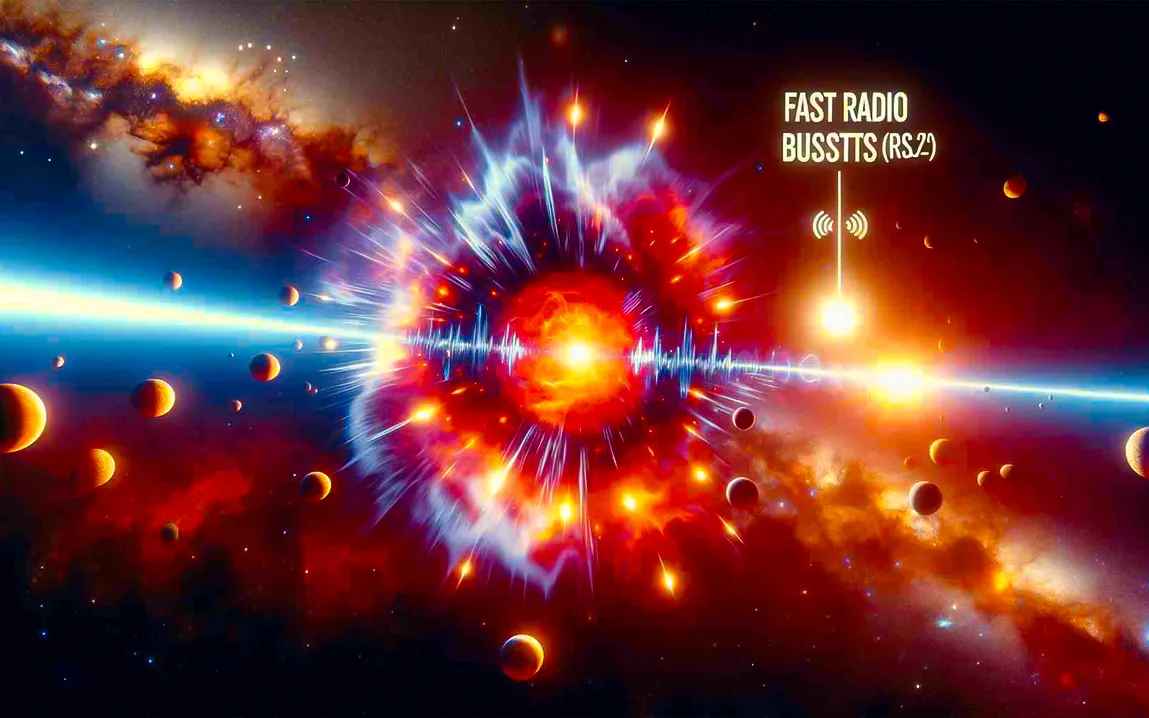Introduction
Fast Radio Bursts, or FRBs, are strong, millisecond-duration pulses of radio waves originating from distant galaxies. Since its discovery in 2007, FRBs have been of intense interest to astronomers because of the mysterious nature surrounding them and the extraordinary energy they radiate. Some recent observations raise questions about their nature, challenging all previous theories concerning their origin.
A Puzzling Discovery
In February 2024, the Canadian Hydrogen Intensity Mapping Experiment (CHIME) discovered a repeating FRB: FRB 20240209A. In the following months, 21 bursts were recorded from this source. What made this discovery most interesting was its provenance: two billion light-years away in a quiescent elliptical galaxy. Elliptical galaxies, sometimes called “dead” because they do not actively host new stars, were thought to be unlikely hosts for FRBs. This discovery contradicts the widely held belief that FRBs are primarily emitted by young, magnetically active neutron stars in star-forming regions.
Implications for FRB Origins
The association of a repeating FRB with an old, inactive galaxy suggests alternative progenitor scenarios. One possibility is that the FRB originates from an older neutron star that has acquired a strong magnetic field through accretion or merger events. The second theory assumes the existence of a magnetar, a neutron star with a very strong magnetic field, and has other origins than through recent supernovae, including the merger of compact objects. These theories postulate that FRB sources could have life cycles and environments far more varied than previously assumed.
Localizing the Source
The discovery of the location of FRBs is essential in understanding their origin. In the case of FRB 20240209A, astronomers used a combination of observations from CHIME and a companion observatory located 60 kilometers away. The dual-observatory system enabled precise triangulation of the source and traced the FRB to the periphery of the massive elliptical galaxy. This method is an important step forward in localizing FRBs, thus providing a template for future research projects that seek to find and explore the host environments of these enigmatic bursts.
Challenging Current Models
The detection of FRB 20240209A in a quiescent galaxy challenges current models associating FRBs with young, fast-rotating magnetars created from recent supernovae. This indicates that alternative models, such as older stellar populations or different formation channels for magnetars, have to be considered. It underlines the need to look into a much broader range of progenitor scenarios to account for the diverse environments in which FRBs are found.
Role of Magnetospheres
Adding a further wrinkle to the FRB puzzle, a different study focused on FRB 20221022A, detected in 2022, established that at least some FRBs are issued from the magnetospheres of neutron stars. Through analysis of scintillation patterns—the changing pattern in radio signals due to transmission through ionized interstellar plasma—researchers found that the emission region of this FRB was highly compact, about 10,000 kilometers in size. This finding suggests that the burst originated within the highly magnetized environment surrounding a neutron star, challenging models that place the emission region far from the central object.
Reevaluating Theoretical Frameworks
These discoveries necessitate a reevaluation of theoretical frameworks concerning FRB production. The fact that FRBs could originate from older stellar populations in quiescent galaxies and from the immediate magnetospheres of neutron stars indicates that possibly multiple progenitor models are needed to explain the entire range of properties observed for FRBs. A diversity in host environments and emission mechanisms suggests that FRBs represent a heterogeneous collection of phenomena from different astrophysical processes.
Future Directions
The study reveals that several observations are still needed together with the sophistication of models needed to understand more about FRBs. Future investigation will be facilitated
by:
- Better Localization: Making use of more radio telescopes in networks leading to higher pinpointing precision as regards FRBs sources, ultimately improving our FRB host environments understanding.
- Multi-Wavelength Observations: Coordinating observations across the electromagnetic spectrum to capture associated emissions, such as X-rays or optical flashes, which can provide additional clues about the progenitors and mechanisms of FRBs.
- Population Studies: Conducting large-scale surveys to identify and categorize FRBs, helping to determine whether distinct subclasses exist and what their respective origins might be.
- Theoretical Modeling: Developing detailed models that can account for the varied properties and environments of FRBs, integrating observational data to fine-tune these theories.
Conclusion
The recent discovery of a repeating FRB from a quiescent elliptical galaxy, coupled with evidence pointing to neutron star magnetospheres as emission sites, has significantly challenged existing paradigms in astrophysics. These findings underscore the complexity of FRBs and the necessity for a multifaceted approach to unravel their mysteries. As astronomers continue to explore these enigmatic bursts, each discovery brings us closer to understanding the full tapestry of high-energy astrophysical phenomena that the universe presents.



